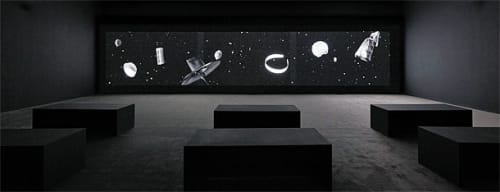By Moon So-Young
Visitors to the Kukje Gallery in central Seoul will encounter mysterious, beautiful objects hanging on the walls - a series of colored wooden panels on which are objects that look like carved brass dishes. The series of objects titled “Bright Starts” and “Seven Stars” are works by the famous Korean artist Park Chan-kyong, 52, and part of his first solo show in five years in Korea, titled “Farewell.”
“The brass objects are myeongdu, which are indispensable to mudang [Korean traditional shamans],” Park said in an interview with the Korea JoongAng Daily late last month. “With the object, mudang are said to commune with the deity or spirit they serve. Every mudang has one or more myeongdu and hangs it on the wall of the shrines or at the site of gut [mudang’s ritual].”
“With the sun, the moon and the Big Dipper stars carved on it, the myeongdu is a symbol of the universe - not as the great frontier that exists in modern science, but as the otherworld that existed in the minds of ancient people,” he continued. “I was interested in it so I created some kind of cosmic skyscapes by putting myeongdu on wooden panels.”
The reactions of viewers, when informed about myeongdu, are interesting. While some look closer with great curiosity, others step back frowning. Koreans generally have mixed and contradictory feelings about the country’s traditional shamanism called musok. It is related to history. The Confucian government of the Joseon dynasty (1392-1910) and then the regimes of modern Korea in the 20th century officially treated musok poorly, partly banning it and calling it a superstition. Still, musok has remained close to those on the margins, especially unprivileged people. And even some in elite society have secretly relied on it...






